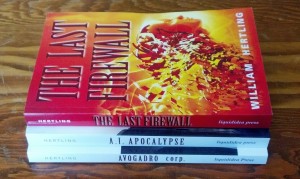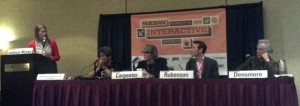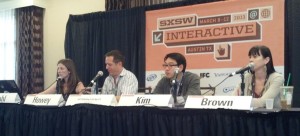Self-Publishing in the Age of E
Hugh Howey (Wool, @hughhowey),
Kirby Kim (William Morris Endeavor, @pantherfist)
Rachel Deahl (Publishers Weekly, @PW_Deals)
Erin Brown (Erin Edits)
#selfpub
· Self-publishing not new. Anyone can publish, find an audience.
· 50 Shades of Gray, essentially self-published, fastest selling adult series of all time.
· Number of books self-published has grown nearly 3x.
· About 250K books self-published books per year.
· Q: More projects start as self-published, and are they of higher quality?
o Kim:
§ Authors trying to show that they have a sales platform, that they can get reviews.
§ But for quality, not necessarily. Even if someone puts something on Amazon, I am still looking at whether the project is appropriate for me, their query letter.
· Q: Has 50 Shades changed things?
o Kim:
§ At one time, it cost money to self-publish, and lots of barriers: hard to get books into stores.
§ It’s a natural result of more ereaders and ease of publishing that more works are self-published.
· Q: Hugh, you went traditional, then self-published.
o Howey: I saw my traditional publisher using the same tools for self-publishing any author would. When I looked at the royalties and the amount of work involved, it was obvious I could do it myself. It’s a startup with zero up front costs if you’re willing to do the work yourself.
· Q: What about pricing?
o Howey: I wanted to make them free, but Amazon wouldn’t let me, so I set them for 99 cents. Then readers would complain that they couldn’t find my books because they were underpriced, so I raised the price.
· Q: When did you decide to get an agent?
o Howey: I didn’t, I was too busy writing. I was pitched by Kristen (his future agent) that I was missing out on all these other markets.
o My sales were a hundred thousand copies per month. Publishers were offering advances comparable to just a few months of royalties.
· Q: When should people go self-published vs. traditionally published?
o Brown:
§ I encourage people to go traditionally published first, including getting an agent who will protect their interests. Publishers are also useful feedback: if you get criticism, then maybe you need to address that feedback.
§
§ Success stories are still few and far between in self-publishing.
o Howey: It’s hard in both paths. And I know hundreds of people online who are quitting their day jobs and earning a modest income from their self-publishing writing, and that is really hard to accomplish with traditional publication.
· Q: “Amazon bestseller” is thrown around a lot, and it’s a slippery term.
o Kim:
§ Agents have to decide that either they are going to work on books they have a passion for, or sometimes they’ll work outside their comfort zone. They’ll think “oh, there’s some money here.” The agent then is left focusing on the wrong thing: the numbers. It makes it hard for them to pick up the phone and call editors and pitch the book with enthusiasm.
§ Some people are successfully leveraging that sales platform.
· Q: Is it harder to find success in either way, given that so many people are self-publishing, is there too much competition?
o Howey:
§ We can’t possibly produce enough material to entertain all the readers.
§ I don’t worry about it. I write because I enjoy it, and I’d keep writing if I never sold a book.
§ Writers are not my competition. We’re all in it together.
o Brown:
§ Finding quality material is about the same: you’re looking for a needle in a haystack. Readers are looking for so many different things. There are storytellers who are great writers, and great writers who aren’t good storytellers. Some people love 50 Shades, and some hate it.
o Kim:
§ All boats rise with the tide. These are dark days in the industry. When you hear of any book working out, it’s good for everyone.
§ Publishers are learning about new markets, markets that were underserved.
· Q: Howey did a unique deal with S&S. Can you tell us about that?
o Howey:
§ It make be dark days for publishing, but publishers are making record profits. The upside for ebooks is huge.
§ I said to publishers, if you want the print rights, you can have them, but I’m keeping the e-rights. I get paid every month with ebooks, I can’t afford to give that up, and only get paid every six months.
§ S&S came to me with the deal I had wanted all along: they bought the print rights, and left all the erights with the Howey.
§ I still want to be an indie author. “I don’t want the stigma of being with a big publisher.”
o Kim:
§ Ebooks are outselling print books now.
§ So it’s extremely rare for a publisher to give that up.
§ Howey had an a lot of leverage based on the strength of his sales.
o Howey:
§ I’m not the first person to do this, and I’m not the last. Next year we’ll have a panel on how to do print-only negotiations.
§ The publisher sees the sales, and they’d rather have part of something, than nothing.
o Kim:
§ It’s hard to bootstrap sales from nothing. Having sales is a big deal.
· Q: What were you selling in digital versus print, and how did you sell those print copies?
o Howey:
§ The up-front cost of producing physical books has gone to zero.
§ Fans will want them. You need to bring them to signings. They’re nice to have on your shelf. Some readers are always going to want print books.
§ When you sell hundreds of thousands of books, people are going to talk about it. When the coworker who doesn’t have an ereader wants it, they look for a print copy. When a Barnes and Noble gets 5 people who ask for a book, they’re going to stock it at a bookstore.
§ S&S has done a second print run of the hardback already. True fans want the ebook and then they also want the print copy too.
· Q: The success stories (Amanda Hocking, Bella …, etc.) are genre writers with a lot of books self-published. Do you need to be writing genre fiction? And do you need a lot of books published?
o Brown: It’s helpful to write that way. In traditional publishing, I dealt mostly with genre fiction. They have rapid fans who want to read a lot of books, at least a book or two a year. If a writer publishes a book every five years, they can’t sustain their fan base.
o Kim.
§ Agree with above. Genre readers, who read a lot of books, have a particular affinity for the ebook form. They don’t want a stack of 100 physical books.
§ For commercial novels, you need to get into the 50,000 sales range before they are impressed. 5,000 sales doesn’t cut it anymore, unless you’re talking about a literary novel.
o Howey: We have to remember what readers want. Look at TV, and what’s popular. People want fun, they want escapism. They want Twilight and 50 Shades.
o Kim: You also see people coming out of MFA programs and they want to write a literary genre novel: it’s a science fiction setting, but it’s a sophisticated writing style. They’re elevating the entire category.
· Q: Is Hollywood having a hunger for self-pubbed works, or are they just motivated by sales?
o Kim: Hollywood wants commercial stories, and most self-pubbed successes are very commercial. Hollywood is looking for a good story.
o Howey: Hollywood is dying for the next thing. They’ll option a twitter feed or a grocery list. The economics are different: $5,000 is a big deal for a publisher, and it’s a valet ticket for Hollywood.
· Q: Is erotica tapped out after 50 Shades?
o Brown: Romance and erotica has been around forever. It’s not changing.
o Kim: We see 50 Shades and knockoffs on the racks even at airports now.
o Howey: I think the anonymity of ereaders and reading online allowed it to expand. We’ll never see another 50 Shades, because you’ll never be able to brag about reading BDSM erotica again. Once is curiosity, and twice is perversion.
o New Adult: It’s YA books, ramped up, and more explicit, with risqué sexual themes.
o Howey: The books are following the readers. Harry Potter readers became Twilight readers.
· Q: What’s the biggest misconceptions about traditional and self-publishing?
o Brown:
§ MisCon: That traditional publishers are heartless corporations out to extract every last dime. But publishers are full of people who love and breath books, and want them and the authors to succeed.
§ MisCon: That you’re going to get a big advance and quit your day job. It’s not going to happen, and it’s split among four payments over a year or more.
§ MisCon: That, for self-publishing, that you don’t need an editor. And that success is easy or overnight.
o Kim:
§ We’re all in it because we love it. Discovery is the best part of the job, championing and advocating for it.
§ MisCon: That your job is over once the publisher has the book. You have a lot of work ahead of you, lots of pounding the pavement, lots of work to get the word out.
§ MisCon: That self-pub is easy. The odds are still against you.
o Howey:
§ Everyone I worked with at traditional publishing has been amazing, even the ones I had to say no to.
§ MisCon: That once you get an agent or a book out there, that you have a career ahead of you. The reality is that you have six months to prove yourself. In my case, it took three years for me to take off. I’ve had friends whose dreams has been crushed when the traditional publishing didn’t turn out the way they wanted.
§ MisCon: That self-pub and traditional pub is very different in quality. They aren’t, the only difference is that the self-pub slushpile is available for purchase. If you look at the top 1%, they are of roughly equal quality.
· Questions from audience
o Q: Why would an author who does the hard work to build an audience, why would you go with a traditional publisher?
§ Howey:
· Publishers are doing e-only imprints to get authors into the stable early, because once a book becomes big, it is too expensive for them to acquire.
· We will see more hybrid deals.
§ Kim:
· Publishers can help you break out, reach new audiences, at a faster pace.
· Publishers can help you get reviews, they can give you some financial security up front.
o Q: From an editors point of view, do you have a preference for who to work with? What should selfpub authors do to not make their editors mad?
§ Brown: I’m never mad at my writers. I always work directly with writers. I get a clients manuscript in the best shape possible, whether they are pitching agents or self-publishing. I can’t make promises. It’s a collaborative relationship to make the best relationship possible.
o Q: What are you seeing for kid’s books, especially with ereaders? Is there much talk in the industry about it?
§ Deahl:
· All of the children’s publishers see apps as a major potential revenue stream. It’s not been the business they’ve been in, so it’s something new. Is it the product? It is ancillary? How do we price it? How do we link it to the book?
· No obvious examples of anything that’s been big revenue generators.
o Q: Are there any creative, outside the box examples of authors who were able to market their books?
§ Kim: John Green, his first thousand books he sold on Amazon were signed copies. He always had a fan base, so this was a big boost for that book. He also has done a lot of viral videos with his brother.
§ Howey: science fiction author did his own audiobooks serially.
o Q: As a big six publisher, what can we do, within reason, to recruit new authors and keep them happy?
§ Howey: Pay us monthly, and show us real-time sales, so I can see the effects of the marketing I do.
§ Kim: We have full agency meetings about marketing. We have our own brainstorming meetings for marketing our authors. We want publishers to come to us early and have a candid conversation about marketing and trying new things. Too often we see the same old stuff.
o Q: How can business founders who are writing business or self-help books market their books?
§ Howey: it’s easier for those kinds of books, you just need to get the meta-data right, so people can find it when they search for the topic.
o Q: Lots of new digital marketing tools out there like goodreads. Are you using them, and what do you use?
§ Howey: My blog post this morning was thanking my goodread readers. It’s good to engage with your readers, rather than try to brow-beat other people into your books.
o

















